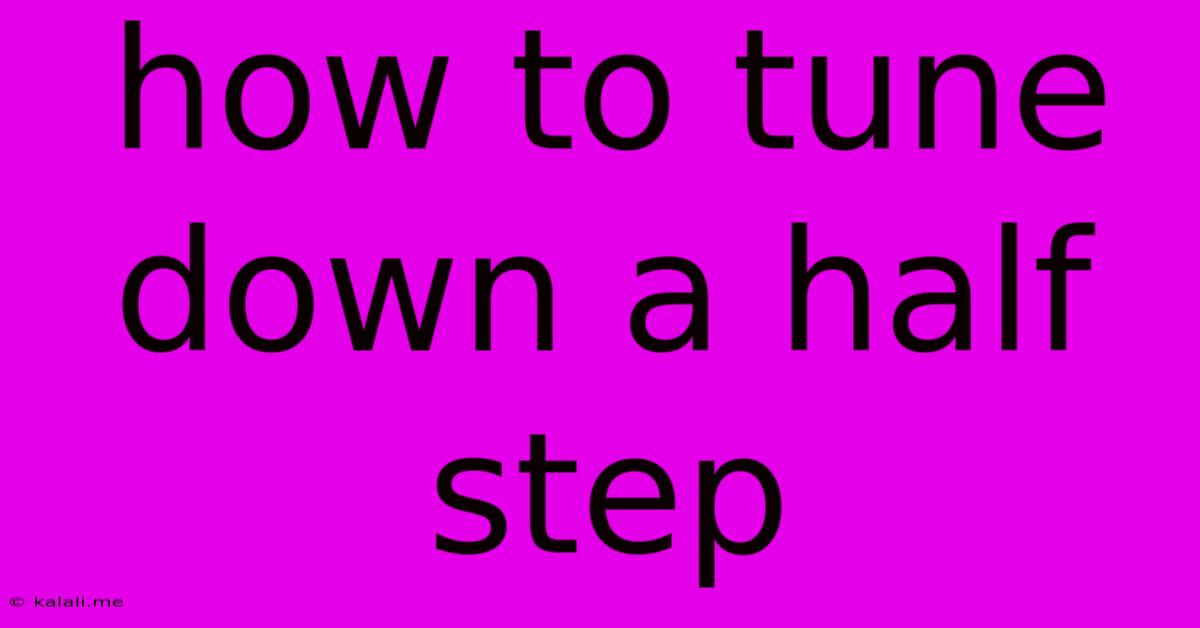How To Tune Down A Half Step
Kalali
May 31, 2025 · 4 min read

Table of Contents
How to Tune Down a Half Step: A Guide for Musicians
Meta Description: Learn how to tune your guitar, bass, ukulele, or other instrument down a half step, including the theory behind it and practical tips for various tuning methods. This guide covers both electronic and manual tuning techniques.
Tuning your instrument down a half step (also known as a semitone) is a common practice among musicians, often used to achieve a darker, heavier, or simply different tonal quality. This process involves lowering the pitch of each string by one half step. Whether you're playing guitar, bass, ukulele, or another instrument, understanding how to do this correctly is crucial for maintaining proper intonation and achieving the desired sound. This guide will walk you through the process, covering both electronic and manual tuning methods.
Understanding the Half Step
Before we dive into the tuning process, it's important to understand what a half step is. A half step is the smallest interval in Western music. On a standard guitar, moving from one fret to the next represents a half step. Tuning down a half step means lowering the pitch of each string by this smallest interval.
Methods for Tuning Down a Half Step
There are several ways to tune your instrument down a half step:
1. Using a Digital Tuner:
This is the most accurate and convenient method. Most digital tuners have a "transpose" or "tuning" function. Simply select the desired tuning (usually "half step down" or "-1 semitone") and follow the tuner's instructions to adjust each string individually. The tuner will display the pitch of each string, guiding you to tune it down precisely. Different tuners might display this in various ways, some might just show a flat symbol next to the note name.
2. Using an App:
Many smartphone apps offer accurate tuning capabilities, often with the same transposition feature as digital tuners. These apps provide visual and auditory feedback, making the tuning process easier, especially for beginners.
3. Manual Tuning (Using Another Instrument):
If you don't have a tuner, you can use another instrument already tuned to the desired half-step-down tuning as a reference. Play a note on your reference instrument and match it to the corresponding string on your instrument, carefully adjusting until they match. This method requires a good ear and some practice.
4. Relative Tuning (Without a Reference):
This method is more challenging and requires a strong understanding of intervals. If you know the standard tuning of your instrument, you can deduce the half-step-down tuning by remembering that each string will be a half step lower than its original pitch. This is only recommended if you have a good understanding of musical theory. It is important to note that this method is less accurate than others.
Tuning Your Instrument Down a Half Step: A Step-by-Step Guide (using a tuner)
Regardless of the method chosen, the process remains essentially the same:
- Select Your Tuning Method: Choose your preferred method from the ones listed above.
- Choose your tuning: Select "half step down" or "-1 semitone" on your tuner or app.
- Tune Each String Individually: Begin with the lowest string and carefully adjust its tuning peg until the tuner indicates that it is correctly tuned a half step down. Repeat this process for each string, ensuring that each string is tuned accurately before moving on to the next.
- Check Intonation: Once all strings are tuned, play some chords and scales across the fretboard. Listen carefully for any inconsistencies or buzzing. This will help to identify any tuning discrepancies.
- Retune if necessary: Make minor adjustments if required to ensure perfect intonation.
Important Considerations:
- Intonation: Tuning down can slightly affect the intonation of your instrument. Pay close attention to how your instrument sounds across the fretboard.
- String Tension: Tuning down reduces string tension, which can affect the tone and sustain of your instrument. You may need to adjust your playing technique to compensate.
- Instrument Type: The specific tuning process can vary slightly depending on the instrument (e.g., guitar, bass, ukulele). Always consult resources specific to your instrument type for detailed instructions.
By following these steps and understanding the underlying principles, you'll be able to successfully tune your instrument down a half step and unlock new sonic possibilities. Remember to always practice safe tuning techniques to avoid damaging your instrument.
Latest Posts
Latest Posts
-
Probability Not A And Not B
Jun 01, 2025
-
Is It Possible To Have An Exponent Inside A Radical
Jun 01, 2025
-
Can You Add Boiled Linseed Oil To Latex Paint
Jun 01, 2025
-
What Is The Legal Drinking Age In Jamaica
Jun 01, 2025
-
Libgl Error No Matching Fbconfigs Or Visuals Found
Jun 01, 2025
Related Post
Thank you for visiting our website which covers about How To Tune Down A Half Step . We hope the information provided has been useful to you. Feel free to contact us if you have any questions or need further assistance. See you next time and don't miss to bookmark.